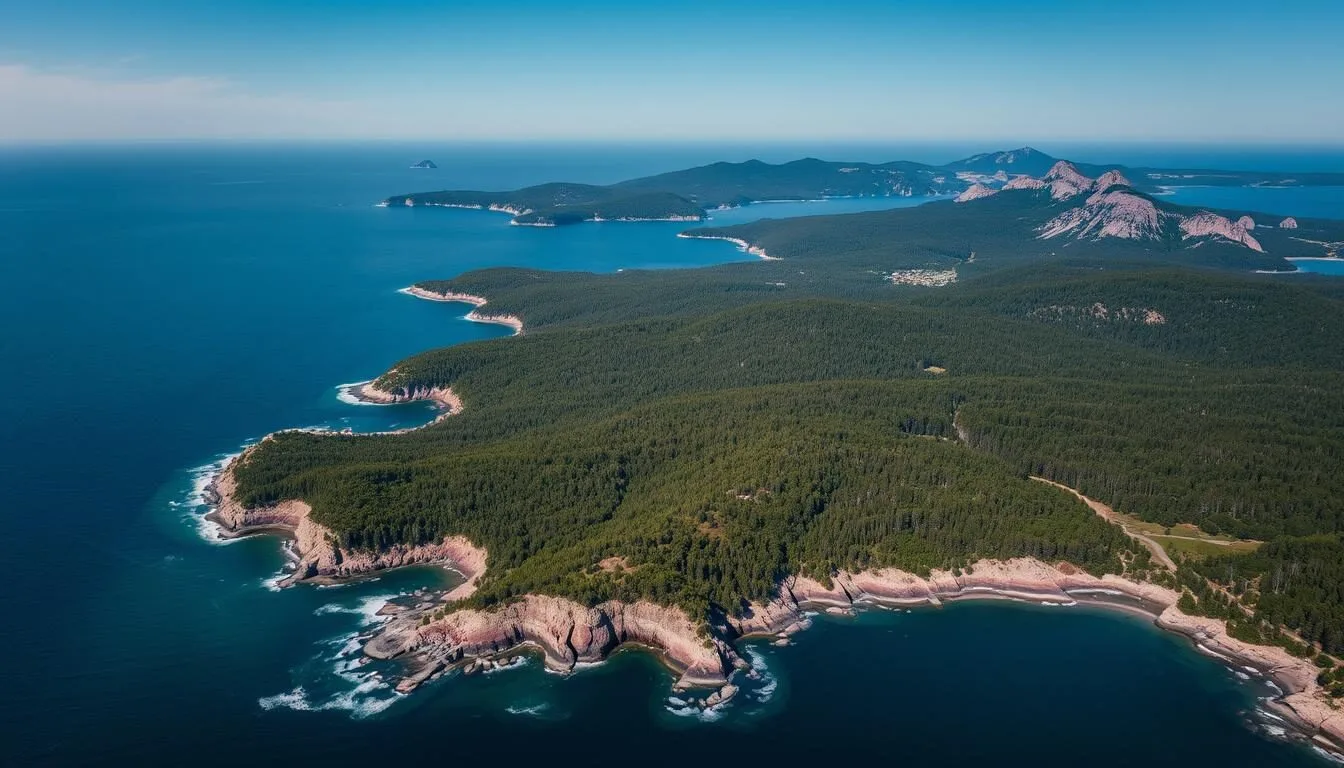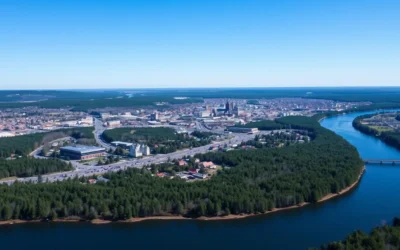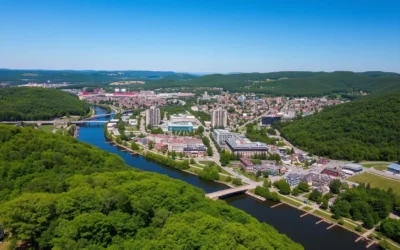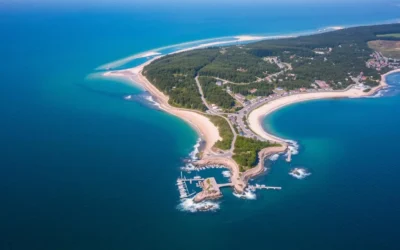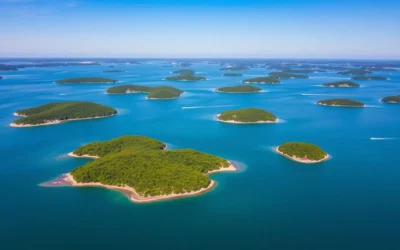Did you know that Acadia National Park receives over 4 million visitors annually despite being one of the smallest national parks in the United States? At just 49,075 acres, this coastal Maine treasure packs an incredible diversity of landscapes into a relatively compact area, offering some of the most dramatic scenery on the eastern seaboard. From the first rays of sunrise touching American soil on Cadillac Mountain to the thunderous waves crashing at Thunder Hole, Acadia combines mountain, forest, and ocean environments in a way few other destinations can match.
Getting to Acadia National Park
Acadia National Park is located on Mount Desert Island along Maine’s rugged coastline. The park is approximately a 5-hour drive from Boston and about 3 hours from Portland, Maine. If you’re flying in, you have several options:
- Hancock County-Bar Harbor Airport (BHB) – The closest airport, just 10 miles from Acadia, with direct flights from Boston
- Bangor International Airport (BGR) – About 50 miles from the park, with more flight options from major cities
- Portland International Jetport (PWM) – Approximately 160 miles from Acadia, offering the most flight connections
Ready to Start Your Acadia Adventure?
Find the best flight deals to Maine and start planning your Acadia National Park getaway today.
If you’re driving, take I-95 to Bangor, then Route 1A to Ellsworth, followed by Route 3 to Bar Harbor. The scenic drive offers glimpses of Maine’s picturesque coastal towns and landscapes, making it an enjoyable part of your journey.
For those who prefer public transportation, the Bar Harbor Shuttle connects from Bangor, though service is limited and seasonal. Once you arrive, having your own vehicle or renting one locally will give you the most flexibility for exploring the park.
Planning Your Journey

A successful visit to Acadia National Park begins with proper planning. The park requires entrance passes, which can be purchased online through Recreation.gov or at visitor centers upon arrival. As of 2023, a 7-day vehicle pass costs $35, while individual passes (for those entering on foot or bicycle) are $20.
- Park Pass – Required year-round for all visitors 16 and older
- Cadillac Summit Road Reservation – Required May through October for driving to the summit
- America the Beautiful Pass – If you plan to visit multiple national parks, consider this annual pass for $80
For Cadillac Mountain visits during peak season (late May through October), you’ll need a separate vehicle reservation to drive the Summit Road, which can be secured up to two months in advance. These reservations often fill quickly, especially for sunrise time slots, so book as early as possible.
Need a Vehicle for Your Acadia Adventure?
Explore Acadia National Park at your own pace with a rental car. Compare prices and book today.
Before your visit, download the official Acadia National Park app, which provides offline maps, trail information, and ranger program schedules. The National Park Service website also offers up-to-date information on trail closures, weather conditions, and special events.
When to Visit Acadia National Park

Each season in Acadia National Park offers a unique experience, though the park’s full services are only available from late May through mid-October.
Summer (June-August)
Peak season with warm temperatures (70-80°F/21-27°C) and all facilities open. Expect crowds, especially in July and August. Perfect for swimming, hiking, and boating. Advance reservations highly recommended.
Fall (September-October)
Spectacular foliage with comfortable temperatures (45-65°F/7-18°C). Fewer crowds after Labor Day until foliage peaks in mid-October. Ideal for photography and hiking. Many consider this the best time to visit.
Spring (April-May)
Quiet season with cool temperatures (40-60°F/4-16°C) and occasional rain. Limited services until late May. Good for birdwatching and enjoying wildflowers. Be prepared for mud on trails.
Winter (November-March) offers a serene, snow-covered landscape for those seeking solitude. While most park roads close, the carriage roads remain open for cross-country skiing and snowshoeing. Services are minimal, and temperatures typically range from 15-35°F (-9-2°C).
“The best time to visit is early June or September after Labor Day. You’ll enjoy pleasant weather without the peak summer crowds.”
For the best experience, consider visiting on weekdays and starting your day early (before 9 AM) or later in the afternoon (after 3 PM) to avoid the largest crowds, especially during summer months.
Getting Around Acadia National Park

Navigating Acadia National Park is relatively straightforward, with several transportation options to suit different preferences:
- Island Explorer Shuttle – Free shuttle service operating from late June through early October, connecting Bar Harbor with popular park destinations. The shuttle helps reduce traffic congestion and parking issues during peak season.
- Private Vehicle – Offers the most flexibility for exploring the park. The 27-mile Park Loop Road provides access to major attractions, though parking can be limited at popular sites during peak hours.
- Bicycle – An excellent way to experience the park, especially on the 45 miles of carriage roads. Bike rentals are available in Bar Harbor and other locations around Mount Desert Island.
- On Foot – With over 150 miles of hiking trails, walking is often the best way to immerse yourself in Acadia’s natural beauty.
The Island Explorer shuttle is particularly useful during busy summer months when parking at popular attractions can fill up by mid-morning. The shuttle connects to all major park destinations and several campgrounds, making it convenient for day hikers and campers alike.
For those exploring by car, note that the Park Loop Road is primarily one-way, with the Ocean Drive section being particularly popular. During peak season, consider starting your drive early in the morning or later in the afternoon to avoid the heaviest crowds.
Cyclists should be aware that while biking is permitted on all park roads, the narrow, winding nature of some sections can make sharing the road with vehicles challenging. The carriage roads, which are closed to motor vehicles, offer a safer and more relaxing cycling experience.
For detailed maps and transportation information, visit the Acadia Carriage Roads guide, which provides excellent resources for navigating the historic road system.
Where to Stay Near Acadia National Park

Acadia National Park offers a range of accommodation options, from camping under the stars to luxurious coastal resorts. Here’s where to consider staying during your visit:
Camping Inside the Park
- Blackwoods Campground – Open year-round (with limited winter facilities), located close to Bar Harbor and Ocean Drive
- Seawall Campground – Open late May through September, on the quieter western side of Mount Desert Island
- Schoodic Woods Campground – Open late May through early October, located on the Schoodic Peninsula section of the park
All park campgrounds require reservations through Recreation.gov, which can be made up to two months in advance. Sites typically cost $30 per night for standard tent sites.
Bar Harbor Accommodations
As the gateway to Acadia, Bar Harbor offers the widest selection of lodging options:
- Luxury Hotels – The Bar Harbor Inn and Balance Rock Inn offer upscale accommodations with ocean views
- Mid-Range Options – Acadia Inn and Highbrook Motel provide comfortable stays at more moderate prices
- Bed & Breakfasts – Numerous historic B&Bs like the Primrose Inn and Saltair Inn offer charming accommodations with personalized service
Other Mount Desert Island Towns
For a quieter experience, consider staying in one of the island’s other charming communities:
- Northeast Harbor – Upscale and quiet, with elegant inns like the Asticou Inn
- Southwest Harbor – Relaxed atmosphere with options like the Claremont Hotel
- Bass Harbor – Small fishing village with vacation rentals and the Bass Harbor Cottages & Country Inn
Find Your Perfect Acadia Accommodation
From oceanfront hotels to cozy cabins, find the ideal place to stay during your Acadia adventure.
For budget travelers, private campgrounds outside the park like Bar Harbor Campground and Mount Desert Campground offer additional options, often with more amenities than park campgrounds.
Regardless of where you choose to stay, booking well in advance is essential, especially for visits during the peak summer season or fall foliage period when accommodations throughout the region fill quickly.
Top Attractions in Acadia National Park

Cadillac Mountain
As the highest point on the North Atlantic seaboard at 1,530 feet, Cadillac Mountain offers spectacular 360-degree views of Mount Desert Island, Frenchman Bay, and the surrounding ocean dotted with islands. From October through early March, it’s the first place in the United States to see the sunrise. The 3.5-mile Summit Road provides vehicle access (reservation required during peak season), or you can hike up via several trails of varying difficulty.
Park Loop Road
This 27-mile scenic drive connects many of Acadia’s most popular attractions. The road includes both forested sections and the dramatic Ocean Drive portion that hugs the coastline. Key stops along the route include:

- Thunder Hole – A natural rock formation where waves crash into a narrow channel, creating a thunderous sound and spectacular splash that can reach up to 40 feet high during the right conditions
- Sand Beach – A rare sandy beach nestled between granite mountains and rocky shores, offering a refreshing (though chilly) swimming spot
- Otter Cliff – One of the highest coastal headlands in the eastern United States, rising 110 feet above the ocean
- Jordan Pond – A crystal-clear glacial lake with stunning views of the rounded mountains known as the Bubbles
Carriage Roads

These 45 miles of crushed-stone pathways were a gift from philanthropist John D. Rockefeller Jr., designed for horse-drawn carriages and now perfect for walking, biking, and horseback riding. The roads feature 17 elegant stone bridges, each with a unique design, and wind through some of the park’s most beautiful landscapes. In winter, these paths become popular routes for cross-country skiing and snowshoeing.
Bass Harbor Head Lighthouse

Perched dramatically on a cliff overlooking the entrance to Bass Harbor, this iconic lighthouse has been in operation since 1858. It’s one of the most photographed locations in the park, especially at sunset when the light bathes the white lighthouse and surrounding granite in golden hues. A short trail leads to viewing platforms below the lighthouse for classic postcard views.
For more information on these and other attractions, the Friends of Acadia website offers excellent visitor resources and insider tips.
Best Hiking Trails in Acadia National Park

With over 150 miles of trails ranging from easy woodland walks to challenging mountain climbs, Acadia offers hiking experiences for all skill levels. Here are some of the park’s most rewarding trails:
Easy Trails
- Jordan Pond Path – 3.3-mile loop around the pristine Jordan Pond with level terrain and stunning views of the Bubbles mountains
- Ocean Path – 4-mile out-and-back trail following the dramatic coastline from Sand Beach to Otter Point
- Ship Harbor Trail – 1.3-mile figure-eight loop through spruce forest to a picturesque harbor on the “quiet side” of the island
Moderate Trails
- Gorham Mountain Trail – 1.8-mile round trip with panoramic ocean views and moderate elevation gain
- Beehive Loop Trail – 1.4-mile loop featuring iron rungs and ladders (not for those with a fear of heights) with spectacular views of Sand Beach
- Acadia Mountain Trail – 2.5-mile loop with views of Somes Sound, the only fjord on the eastern seaboard
Challenging Trails
- Precipice Trail – 1.6-mile one-way climb up the face of Champlain Mountain using iron rungs and ladders (often closed in spring/early summer for peregrine falcon nesting)
- Cadillac South Ridge Trail – 7.1-mile round trip to the summit of Cadillac Mountain with gradual but sustained elevation gain
- Jordan Cliffs Trail – 3.2-mile loop with exposed sections, iron rungs, and stunning views of Jordan Pond
“The Precipice Trail isn’t just a hike—it’s an adventure. The iron rungs and ladders make it feel like a natural jungle gym with the reward of breathtaking views.”
For detailed trail maps and current conditions, check with rangers at visitor centers or visit the Maine Trail Finder website. Remember to bring plenty of water, appropriate footwear, and layers for changing weather conditions.
Trail Safety Tip: Many of Acadia’s trails traverse exposed granite surfaces that can become extremely slippery when wet. Consider postponing challenging hikes during or after rain, and always wear appropriate footwear with good traction.
Water Activities in Acadia National Park

Surrounded by the Atlantic Ocean and dotted with lakes and ponds, Acadia National Park offers numerous opportunities for water-based recreation:
Ocean Activities
- Sea Kayaking – Paddle along the rugged coastline, exploring hidden coves and getting a unique perspective of the park from the water. Guided tours are available from operators like in Bar Harbor.
- Boat Tours – Several companies offer scenic cruises, nature tours, and lighthouse excursions from Bar Harbor and other towns around Mount Desert Island.
- Tidepooling – At low tide, explore the fascinating marine life in tidepools at Ship Harbor, Wonderland, and Bar Island.
Freshwater Activities
- Swimming – Echo Lake and Lake Wood offer warmer freshwater swimming alternatives to the chilly ocean at Sand Beach.
- Canoeing and Kayaking – Peaceful paddling on Jordan Pond, Eagle Lake, and Long Pond, with rentals available at locations outside the park.
- Fishing – Try your luck catching bass, trout, and other species in the park’s lakes and ponds (Maine fishing license required).
Water temperatures in the Atlantic around Mount Desert Island rarely exceed 55°F (13°C) even in summer, making wetsuits advisable for extended water activities. The park’s freshwater lakes and ponds offer more comfortable swimming temperatures, typically reaching the mid-70s°F (mid-20s°C) by July.
Safety Note: Always check weather and tide conditions before engaging in ocean activities. Fog can roll in quickly along the Maine coast, and tidal changes can be significant.
For those interested in learning about marine ecology while exploring, consider joining a guided tidepool walk led by park rangers during summer months, or book a nature cruise to observe seals, porpoises, and seabirds in their natural habitat.
Wildlife Viewing in Acadia National Park

Acadia National Park hosts diverse ecosystems that support abundant wildlife. Here’s what to watch for and where to find it:
Land Animals
- White-tailed Deer – Common throughout the park, especially at dawn and dusk in meadows and forest edges
- Red and Gray Squirrels – Abundant in wooded areas
- Snowshoe Hare – More commonly seen in early morning or evening in forested areas
- Red Fox – Occasionally spotted in open areas and along roadsides
- Moose – Rare but occasionally seen in wetland areas on the “quiet side” of the island
Marine Life
- Harbor Seals – Often visible hauled out on coastal rocks or swimming offshore
- Porpoises – Sometimes spotted from coastal viewpoints or during boat tours
- Whales – Occasionally seen from high points like Cadillac Mountain or on whale-watching tours from Bar Harbor
- Tidepool Creatures – Starfish, sea urchins, crabs, and anemones can be observed at low tide
Birds

- Peregrine Falcons – Nest on the Precipice and Jordan Cliffs (trails in these areas are often closed during nesting season)
- Bald Eagles – Frequently seen soaring over coastal areas and lakes
- Common Loons – Present on Jordan Pond and other freshwater bodies
- Seabirds – Gulls, cormorants, eiders, and occasionally puffins (on offshore islands)
- Warblers and Songbirds – Abundant in spring and summer throughout forested areas
The best times for wildlife viewing are early morning and late afternoon when animals are most active. Bring binoculars and maintain a respectful distance from all wildlife. For serious birders, spring migration (May-June) offers the greatest diversity of species.
The Schoodic Institute offers excellent resources for bird watching in the park, including checklists and seasonal highlights.
Wildlife Viewing Tip: Keep noise to a minimum, move slowly, and scan carefully. Many of Acadia’s animals are well-camouflaged and easily startled by loud voices or sudden movements.
Where to Eat Near Acadia National Park

The Mount Desert Island area offers excellent dining options, from casual lobster pounds to fine dining establishments. Here are some local favorites:
Inside the Park
- Jordan Pond House – The only restaurant within park boundaries, famous for its popovers (light, hollow rolls) and tea since the 1890s. Offers lunch and dinner with beautiful views of Jordan Pond and the Bubbles mountains. Reservations recommended.
Bar Harbor
- Galyn’s – Seafood and steaks in a historic building with harbor views
- Side Street Cafe – Casual spot known for mac and cheese, burgers, and local beer
- Thrive Juice Bar & Kitchen – Healthy options including smoothies, açaí bowls, and vegetarian fare
- Havana – Upscale Latin-inspired cuisine using local ingredients
- Morning Glory Bakery – Excellent breakfast pastries, breads, and coffee
Around the Island
- Thurston’s Lobster Pound (Bernard) – Classic Maine lobster experience with waterfront picnic tables
- Beals Lobster Pier (Southwest Harbor) – Fresh seafood in a casual setting on the working harbor
- The Burning Tree (Otter Creek) – Farm-to-table dining with emphasis on local seafood and produce
- Islesford Dock Restaurant (Little Cranberry Island) – Destination dining reached by ferry, known for fresh seafood
Local Specialties to Try
- Lobster Roll – Cold lobster meat lightly dressed with mayonnaise in a toasted bun
- Steamed Clams – Soft-shell clams (steamers) served with broth and melted butter
- Blueberry Pie – Made with small, sweet Maine wild blueberries
- Whoopie Pies – Two chocolate cake-like cookies with creamy filling
- Craft Beer – Try local brews from Atlantic Brewing Company or Bar Harbor Brewing
For the best seafood experience, visit a traditional lobster pound where you can select your own lobster from the tank and have it steamed to order. These casual establishments typically serve lobster, clams, and corn on paper plates with plenty of napkins and nutcrackers for a hands-on dining experience.
For more dining recommendations and current restaurant information, check out Bar Harbor Maine’s dining guide.
Practical Tips for Visiting Acadia National Park

Weather and What to Pack
- Layered Clothing – Weather can change quickly; bring layers that can be added or removed
- Rain Gear – The Maine coast can experience fog and rain even in summer
- Sturdy Footwear – Many trails involve granite surfaces that can be slippery
- Sun Protection – Sunscreen, hat, and sunglasses, especially for exposed coastal areas
- Insect Repellent – Helpful for forested areas, particularly in late spring and summer
- Binoculars – For wildlife viewing and enjoying distant vistas
Safety Information
- Tide Awareness – Check tide tables if exploring coastal areas; rising tides can cut off access points
- Trail Conditions – Granite surfaces become extremely slippery when wet
- Cell Service – Coverage is spotty throughout the park; download maps offline before your visit
- Wildlife – Keep a safe distance from all wildlife and never feed animals
- Water Safety – Ocean temperatures rarely exceed 55°F (13°C); be aware of hypothermia risk
Etiquette and Regulations
- Leave No Trace – Pack out all trash and leave natural objects where you find them
- Stay on Trails – Help prevent erosion and protect fragile vegetation
- Pets – Must be leashed (6 feet or less) at all times; not allowed on ladder trails or swimming beaches
- Drones – Not permitted anywhere within Acadia National Park
- Campfires – Only allowed in designated fire rings at established campgrounds
Insider Tip: The park can experience heavy fog, especially in June and July. If you wake up to foggy conditions, head to the western side of Mount Desert Island, which often has clearer weather, or explore inland areas like the carriage roads.
For visitors with mobility concerns, Acadia offers several accessible options, including the Wild Gardens of Acadia, portions of the Ocean Path, and the Jordan Pond House area. The park’s accessibility guide provides detailed information.
Ready for Your Acadia Adventure?
Start planning your perfect trip to one of America’s most beautiful national parks today.
Conclusion

Acadia National Park stands as a testament to the spectacular beauty that emerges when mountains meet the sea. From witnessing the country’s first sunrise atop Cadillac Mountain to exploring tide pools teeming with marine life, Acadia offers experiences that will stay with you long after you’ve returned home. The park’s unique combination of rugged coastline, dense forests, crystal-clear lakes, and historic carriage roads creates an outdoor playground suitable for adventurers of all ages and abilities.
Whether you’re hiking challenging granite peaks, cycling the historic carriage roads, or simply enjoying a lobster roll while watching the sunset over Frenchman Bay, Acadia’s natural splendor and rich cultural heritage provide the perfect backdrop for an unforgettable Maine adventure. As John D. Rockefeller Jr., who donated much of the park’s land, once said, “The important thing is to realize that whatever we possess becomes of value only through the use we make of it.” Make the most of your time in this coastal gem, and you’ll understand why generations of visitors have fallen in love with Acadia National Park.
The above is subject to change.
Check back often to TRAVEL.COM for the latest travel tips and deals.
